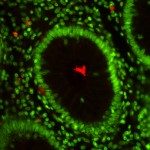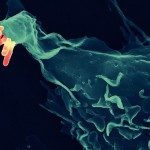Link to Pubmed [PMID] – 16299482
Nat. Methods 2005 Dec;2(12):959-65
Type III secretion (T3S) systems are key features of many gram-negative bacteria that translocate T3S effector proteins directly into eukaryotic cells. There, T3S effectors exert many effects, such as cellular invasion or modulation of host immune responses. Studying spatiotemporal orchestrated secretion of various effectors has been difficult without disrupting their functions. Here we developed a new approach using Shigella flexneri T3S as a model to investigate bacterial translocation of individual effectors via multidimensional time-lapse microscopy. We demonstrate that direct fluorescent labeling of tetracysteine motif-tagged effectors IpaB and IpaC is possible in situ without loss of function. Studying the T3S kinetics of IpaB and IpaC ejection from individual bacteria, we found that the entire pools of IpaB and IpaC were released concurrently upon host cell contact, and that 50% of each effector was secreted in 240 s. This method allows an unprecedented analysis of the spatiotemporal events during T3S.



